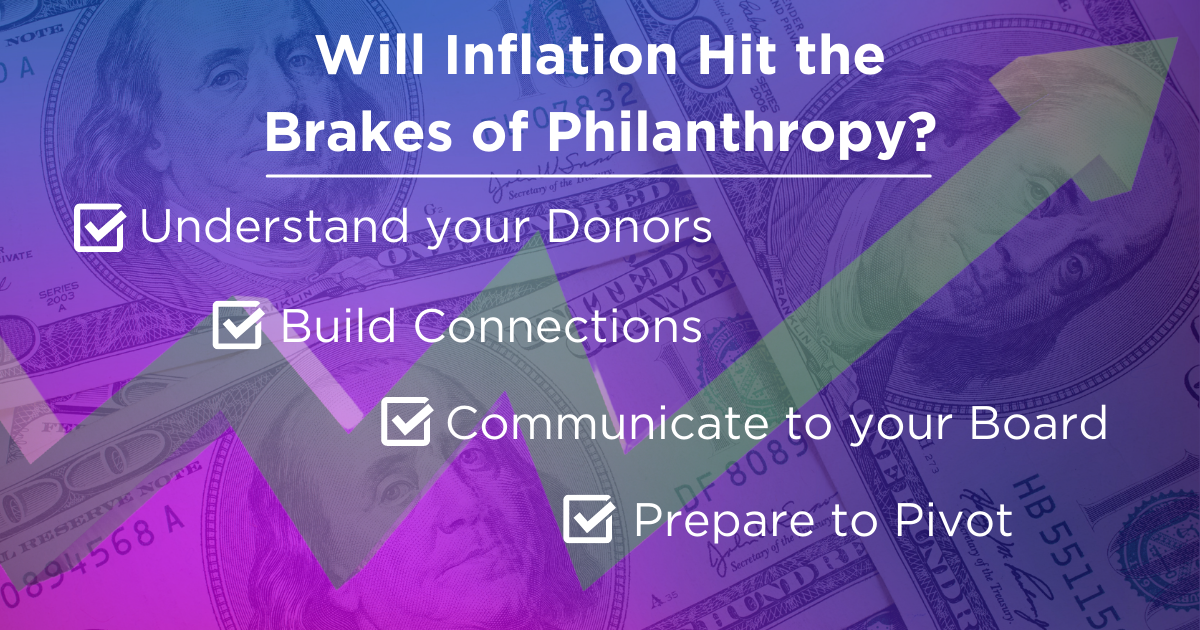Will Inflation Hit the Brakes of Philanthropy?

The cost of everything in the US grew 7% in 2021. For the average household this translates to about $3500 in higher consumer prices for the same products and services that families purchased in 2020 and 2019. As wallets shrink, how will Americans shift their spending and prioritize giving?
Inflation climbed to 5.5% through 2021- the biggest annual jump since February 1991.1 Economists are pointing out that the price hikes we are seeing today are largely due to the disruptive nature of the pandemic on all aspects of society and that uncertainty will persist into 2022. As recently as January 2022, consumer sentiment continued to decline to 68.8 points, the second lowest level in a decade with consumers citing inflation as their number one concern.2
Fundraisers should be concerned along with consumers - inflation reduces spending power and disproportionately affects the low- and middle-income households that drive direct response donations - the primary source of new and mid-level donors for nonprofits. When the economy falters, charitable giving takes a hit.
The Great Recession was an extreme lesson. Total giving dropped by 7.2% in 2008, and then decreased by another 8% in 2009. During economic downturns, more people are out of work and need a hand. But individuals, along with other sources of philanthropy, including foundations, typically are making less income and have reduced wealth available and so they decrease their giving accordingly.” (Rooney and Bergdoll, 2020).
So how will giving be impacted by inflation in 2022? Blackbaud donorCentrics has reported mixed giving trends for its most recent reporting quarter Q3 2021. Overall donor growth has flattened out (but not declined). New donors grew modestly at 2.3%. Revenue was up 8% over 2020 driven from higher average gifts – continued strong performance coming from a record $471 billion in charitable giving in the prior year. A positive, though complicated story will likely accelerate in Q4 2021 metrics.3
Fundraisers can take the wheel. Spending differs across households. As prices continue to rise, it’s a certainty that individuals will evaluate the programs and services that are most important to them - including philanthropic priorities. Fundraisers who are able to position themselves as the charity of choice for their donors will build resiliency for the fundraising programs in the months and years ahead.
As we move forward in these ever-evolving times, here are 4 critical guidelines to maintain and grow your fundraising success.
- Understand Your Donor Base - Listen to your donors. Using your donor data has never been more critical. If you have access to leveraging third party data to truly make your donor segments more robust and definable, now is the time to consider. Perform an assessment to determine who is new, who is most loyal and how communications and fundraising should be targeted to highest potential audiences. Segmentation is key to hyper-personalizing your approach.
- Build Connection with Donors - Prioritize key opportunity segments within your constituency database. Engaging your targeted donor audience at every touch point is what will be the “success solution” during these times. While direct mail, email, and phone calls are consistently powerful connectors, think broader with an omnichannel mindset, including mobile and digital campaigns. Thank supporters and reiterate continued needs, but showcase how they are individually making a difference. Earning trust goes beyond legacy and tenure. It’s about follow-through and accountability. How responsive is your organization to requests from your donors? How are you using data about your supporters to build trust based on their interest?
- Communicate to Your Board – Develop budget projections scenarios and communicate potential impacts of both a downturn as well as enhanced programs and communications to your board. As with your constituency, transparency with your board is just as critical.
- Prepare to Pivot - The pandemic has done nothing if not strengthen our abilities to adapt and adjust. Remain nimble by cultivating continual awareness of present-day performance and by changing when required to do so.
A pandemic, inflation, and supply chain disruptions have a way of putting one’s priorities under a microscope. The stakes have never been higher for fundraisers to effectively assess, target, and engage existing and potential donors at a time when the status quo is in a constant state of change. Are you ready?
1 “Inflation Is Near a 40-Year High. Here’s What It Looks Like,” Peter Santilli and Gwynn Guildford, Modified Dec, 17 2021, https://www.wsj.com/articles/inflation-is-near-a-40-year-high-heres-what-it-looks-like-11639737004
2 “United States Michigan Consumer Sentiment,” Modified Jan 2022, https://tradingeconomics.com/united-states/consumer-confidence
3 “Americans gave a Record $471 Billion to Charity in 2020,” Haleluya Hadero, Modified June, 15 2021, https://fortune.com/2021/06/15/americans-gave-a-record-471-billion-to-charity-in-2020-pandemic/
